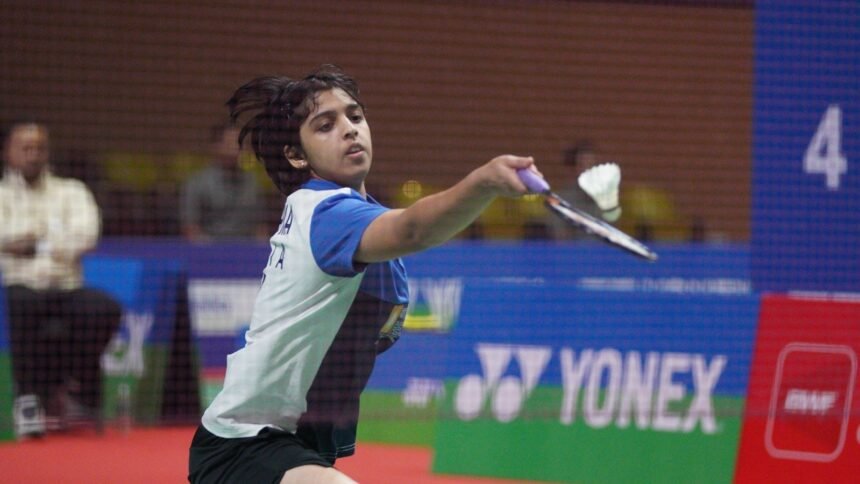Tanvi Sharma knew what obscurity tasted like, in 2022. It was dry and bitter and scratchy-eyed, and like gulping too much of sadness. Leading by a set in badminton’s Senior Nationals final, Tanvi, then just 15, had snapped a hamstring. And just like that, the match ended, her opponent became champion and she was nudged into the wings, fading out of the scene.
At the same arena in Guwahati three years on, where injury robbed her of an early break, Tanvi led 10-6 in a medal-confirming match of the World Juniors against Saki Matsumoto. No Indian woman had medalled at World Juniors since Saina Nehwal in 2008. Losing the opening set, Tanvi forced a decider and was once again staring into a familiar abyss of piling unforced errors at 3-7, when her coach Park Tae-sang told her pithily: ‘This is your last year in World Juniors, so just play the shuttle inside.’ “Last 7 points, he told me just play your everything,” she said. Coach Park had gee-ed up PV Sindhu at Tokyo Olympics to push for a bronze after she was thrashed in the semis. Now, Tanvi needed that belief in her corner.
She would come out of that dark tunnel winning 13-15, 15-9, 15-10, and finally nail down an important medal.
Matsumoto is a typical Japanese, relying on soul-sucking slow rallies, and Tanvi needed to grit it out, drawing out errors even while amping up aggression – the only way to overpower her. Two points stood out. Tanvi, cranking up the pace in her footwork, charged the net at 7-8 down in the decider, and turned her racquet face for a stealthy drop to the front court. The Japanese though saw the wind go out of her sails when on 11-10, Tanvi sent a reflex return at the net, on the backhand, that went down the line, passing Matsumoto. The Japanese couldn’t score a point after that.
Guwahati erupted with joy, chanting the name of that forgotten runner-up from 2022, whose only reason for not crying that night was she had been shell-shocked by the suddenness of the injury.
Speaking to this paper in July, Tanvi had recalled that wretched post-2022 phase. She had wiped out the entire might of India’s gen-next that year. Shiyanshi Valishetty in U19, Tanya Hemanth, Unnati Hooda, Aakarshi Kashyap, and Isharani Baruah thereafter. In the finals, Anmol Kharb would win, and make good her opportunities for the Indian team. “I had to suddenly leave. I felt very, very bad. For three months due to injury I felt very down that I had missed an opportunity. At that age, I was just standing in one place, not able to move on court and there was no maturity that injuries do heal!” she had said.
Her mother Meena, who single-handedly raised two daughters to never give up while playing textbook badminton in Hoshiarpur, Punjab, had helped her out then. Meena, a state volleyball player, taught herself to play badminton. And then taught Tanvi and sister Radhika in turn, literally taking detailed notes about how PV Sindhu, Saina, K Srikanth and Kashyap Parupalli trained in Hyderabad, during the sisters’ short stint there.
Story continues below this ad
The financial crunch was resolved eventually, but no sponsor can fill in gaps of experience you learn only from defeats. Tanvi had a good run at the US Open this year, making the finals in seniors, but at the Asian Juniors, there had been a stumble. She won a bronze alright, but pressure, snatches of which still eat into her confidence, had seen her lose semifinals to the Chinese and miss on a final.
Coaches had not forgotten to remind her of how she had cracked under the strain. Two lessons were clear – physically Indians weren’t as strong, and mentally they could crumble. Going into the World Juniors, Tanvi had been guarding against just that.
She’s been called ‘next Sindhu’ by coach Park, and national head coach Pullela Gopichand has praised her temperament and ability to rustle up a power game when needed. Her smashes sting and she can put a good shoulder behind them as well, though under pressure, she can spray some. Tanvi will be tested against Chinese Liu Si Ya, but there’s a chance for revenge, etc.
She can salvage mistakes like after 3-7 down in the decider. “I didn’t want to think much. I got continuous 3-4 points and got confident. I played my game,” she says. Aggression is her get-out card, and she reads the game perhaps better than Sindhu, to channel it. The net game has improved leaps and bounds. It’s a strength even, while she negotiates sideways drift at an arena where she’s trained in silence for a year, preparing for this.
Story continues below this ad
The crowd support can amp up pressure. “Middle of the match that can mean pressure. But third game it was motivating for me. I’m very happy to win this medal after Saina di,” she said. Nehwal beat a certain Shixian Wang in semis in 2008 Junior Worlds, and the opening set 22-20 was tricky before she fought back against the future Chinese champion. Tanvi knows she will need to fight.








